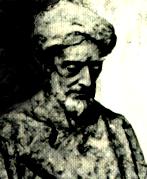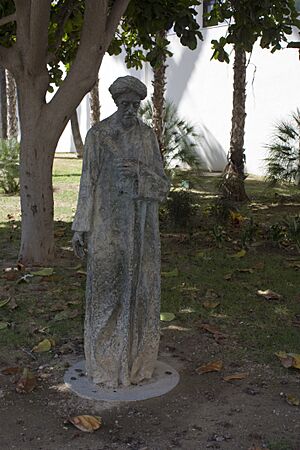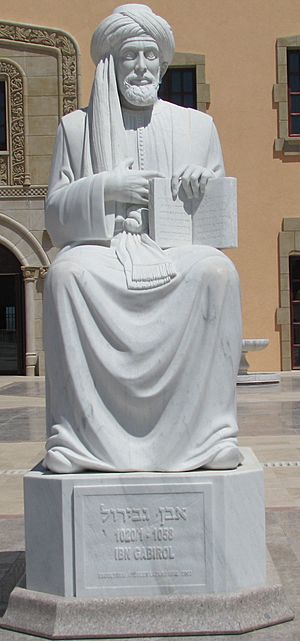Solomon ibn Gabirol facts for kids
Quick facts for kids
Solomon ben Yehuda ibn Gabirol
Avicebron |
|
|---|---|

Modern depiction of Ibn Gabirol
|
|
| Born | 1021 or 1022 |
| Died | 1070 (1050?, 1058?) |
| Other names | Avicebron, Avicebrol |
|
Notable work
|
Fons Vitæ |
| Era | Medieval philosophy |
| Region | Jewish philosophy |
| School | Neoplatonism |
|
Main interests
|
Religious philosophy |
Solomon ibn Gabirol (also known as Avicebron) was an important Jewish poet and thinker who lived in the 11th century in Al-Andalus (which is now Spain). He followed a way of thinking called Neoplatonism, which explores ideas about God and the universe.
Ibn Gabirol wrote more than a hundred poems. He also wrote books about the Bible, philosophy, and how people should behave. Some stories even say he created a golem (a creature made of clay, brought to life) to help with chores!
For a long time, people thought his philosophical work, Fons Vitæ, was written by a Christian or Muslim scholar. This was because medieval translators changed his name to Avicebron. In the 1800s, it was discovered that Avicebron was actually Solomon ibn Gabirol. He is famous for his idea that everything, even thoughts and souls, is made of "matter and form."
Contents
About Solomon ibn Gabirol's Life


We don't know much for sure about Ibn Gabirol's life. Some old writings even give different information. Most sources agree he was born in Málaga, Spain, either in late 1021 or early 1022. The exact year he died is also unclear. Some say he died before he was 30, while others say he lived until he was 48.
Ibn Gabirol didn't have to work for money, but his life was still hard. He was often sick and felt lonely. He also had bad luck with friends and made powerful enemies. From his teenage years, he suffered from a painful illness. He wrote in his poems that he thought he was short and not good-looking.
A writer named Moses ibn Ezra said that Ibn Gabirol had a quick temper. He also said that Ibn Gabirol enjoyed making fun of important people. He has been described as someone who didn't fit in well with society.
Early Life and Challenges
Ibn Gabirol's father was an important person in Córdoba. But his family had to move to Málaga in 1013 because of political problems. Ibn Gabirol's parents died when he was young, leaving him an orphan. He had no brothers or sisters.
A powerful political figure, Yekutiel ibn Hassan, became his friend and supporter. Ibn Gabirol then moved to Zaragoza, a big center for Jewish culture. Even though he had enemies because of his sharp wit, Yekutiel protected him. This allowed Ibn Gabirol to study many subjects like the Talmud, grammar, and philosophy.
When Ibn Gabirol was 17, his friend Yekutiel was killed in a political plot. By 1045, Ibn Gabirol had to leave Zaragoza. Later, he was supported by Samuel ibn Naghrillah, a top general in Granada. Ibn Gabirol praised him in his poems for a while. But then they had a disagreement, and Ibn Naghrillah became the target of Ibn Gabirol's sharp jokes. It seems Ibn Gabirol never married. He spent the rest of his life traveling.
Ibn Gabirol's Early Works
Ibn Gabirol became a skilled poet and philosopher at a young age:
- By age 17, he had written five poems. One poem listed all 613 commandments of Judaism.
- At 17, he wrote a long poem (200 verses) to honor his friend Yekutiel after he died. He also wrote four other poems to mourn the death of Hai Gaon.
- By age 19, he had written a 400-verse poem that taught the rules of Hebrew grammar.
- By age 23 or 25, he wrote "Improvement of the Moral Qualities" in Arabic.
- Around age 25, he might have written a collection of wise sayings called Mivchar Pninim ("Choice of Pearls").
- Around age 28, he wrote his main philosophical work, Fons Vitæ.
How He Died
As mentioned, there are different stories about when Ibn Gabirol died. Some say he died before age 30, but this is likely a mistake. The other ideas are that he died in 1069 or 1070, or around 1058 in Valencia.
One legend says he was trampled by an Arab horseman. Another story says a Muslim poet, jealous of Ibn Gabirol's poetry, murdered him. The poet secretly buried him under a fig tree. The tree then grew amazing, sweet fruit. People noticed how special the tree was and investigated. They found Ibn Gabirol's body, and the murderer was caught and punished.
His Identity in History
Ibn Gabirol's work was respected for centuries. But his historical importance was sometimes missed because of two big mistakes in how his works were credited.
Mistaken for King Solomon
Ibn Gabirol was often called "the Málagan" because he was from Málaga. He sometimes used this in his poems to sign his work. In his time, Málaga was called Mālaqa in Arabic. A philosopher in the 12th century, Jabir ibn Aflah, misunderstood some of Ibn Gabirol's signatures. He thought "Mālaqa" meant "the king." So, he believed that 17 of Ibn Gabirol's philosophical essays were written by Solomon, the famous king. Later, a Jewish philosopher in the 15th century added more works to this false list.
Known as Avicebron
In 1846, a scholar named Solomon Munk made an important discovery. He found a Hebrew manuscript and compared it to a Latin book called Fons Vitæ, which was believed to be by a Christian or Muslim philosopher named Avicebron. Munk proved that both books were based on an original Arabic text. He showed that Avicebron was actually Solomon ibn Gabirol.
This confusion lasted for centuries partly because Fons Vitæ didn't mention Jewish religious ideas or quote from the Bible. The name "ibn Gabirol" slowly changed into "Avicebron" through different translations over time.
Ibn Gabirol's Philosophy
Ibn Gabirol claimed to have written twenty philosophical works. However, we only have the full texts of two of them.
He became famous in philosophy as Avicebron, one of the first teachers of Neoplatonism in Europe. His most well-known idea is that everything, including our souls and minds, is made of "matter and form." He also stressed the importance of God's will.
His role is sometimes compared to Philo, another Jewish philosopher. Both were not widely recognized by their own Jewish communities but had a big impact on non-Jewish thinkers. They also helped connect different cultures and ideas.
Fons Vitæ (Source of Life)
Fons Vitæ means "Source of Life." It was originally written in Arabic and later translated into Hebrew. This book is a philosophical conversation between a teacher and a student. They talk about how the world was created and how understanding ourselves helps us live better lives.
The book's main goal is to help people understand what it means to exist and be human. This understanding can then inspire them to seek knowledge and do good deeds. A key idea in Fons Vitæ is that everything, even our souls and minds, is made of matter and form. It also emphasizes God's will.
Here's a short example from the book:
-
- Student: What is the purpose of man?
- Teacher: For his soul to want to return to the higher world, so that everyone can go back to where they belong.
At the end of the book, Ibn Gabirol says that this "return" means being free from death and connecting with the source of life.
The original Arabic version of Fons Vitæ is lost. But it was saved because it was translated into Latin in 1150. Later, in the 13th century, a summary of the book was written in Hebrew. The full Latin text was finally translated into Hebrew in 1926.
Fons Vitæ has five main parts:
- Matter and form in general, and how they relate in physical things.
- The basic substance that supports the physical world.
- Proofs that there are things between God and the physical world (like spiritual substances).
- Proofs that these spiritual substances are also made of matter and form.
- Universal matter and universal form (the most basic forms of matter and form).
The book suggests that everything that exists comes from a combination of "universal matter" and "form." Its main ideas are:
- Everything that exists can be put into three groups: God, creation (matter and form), and will (something in between).
- All created things are made of form and matter.
- This is true for both the physical world and the spiritual world. The spiritual world connects God to the physical world.
- Matter and form are always connected, like a base and its properties.
Influence on Jewish Thought
Even though Jewish thinkers didn't pay much attention to Ibn Gabirol's philosophy directly, his ideas spread through his poetry. His most famous poem, Keter Malkut ("Royal Crown"), is like a philosophical book in poem form. For example, one line in the poem talks about an idea from Fons Vitæ: that qualities we describe about God only exist in our thoughts, not as separate things in reality.
Some Jewish philosophers, like Moses ibn Ezra and Joseph ibn Tzaddik, mentioned or used ideas from Fons Vitæ in their own writings. However, Abraham ibn Daud, another 12th-century philosopher, disagreed with Ibn Gabirol's ideas. He praised Ibn Gabirol as a poet but criticized his philosophy for not focusing enough on Jewish religious beliefs.
Some ideas from Ibn Gabirol's work can also be found in later Kabbalistic writings (Jewish mystical texts).
Influence on Christian Scholars
For over 600 years, Christian scholars thought Fons Vitæ was written by a Christian or Muslim philosopher. It became a very important book in many religious debates between different Christian groups, like the Franciscans and Dominicans. The Dominicans, who followed Aristotle's ideas, disagreed with Fons Vitæ. But the Franciscans, who followed Platonism, supported its teachings. This helped Ibn Gabirol's ideas become accepted in Christian philosophy.
Some key points of disagreement between Ibn Gabirol and a famous Christian philosopher, Thomas Aquinas, were:
- Ibn Gabirol believed all things, even spiritual ones, had matter. Aquinas thought spiritual things were not material.
- Ibn Gabirol believed physical things could have many forms. Aquinas disagreed.
- Ibn Gabirol believed physical beings had the power to act.
Creation from Nothing
Ibn Gabirol did not believe in the idea of "creation ex nihilo" (creation out of nothing). He felt that this idea would make God "subject to the laws of existence."
Ethics: How to Live Well
The Improvement of the Moral Qualities
| Sight | Hearing |
|
Pride |
Love |
| Smell | Taste |
|
Wrath |
Joy (cheerfulness) |
| Touch | |
|
Liberality |
|
The Improvement of the Moral Qualities is a book about ethics, which means how to live a good life. It was written in Arabic in 1045. Ibn Gabirol wrote it because his friends wanted a book about human qualities and how to make them better.
What was new about this book is that it talked about ethics without focusing on religious rules. It also suggested that our five senses are symbols of good and bad qualities. But the senses themselves are not the cause of good or bad behavior. This means that if a person tends to do bad things, they can choose to change. Ibn Gabirol shows how 20 different qualities are related to the five senses. He encourages readers to train their souls to be good through self-understanding and practice. He believed that humans' ability to do this shows God's kindness.
This book is not widely studied in Judaism today. However, it has many similarities to another popular book, Chovot HaLevavot, written around the same time.
Mivchar HaPeninim (Choice of Pearls)
Mivchar HaPeninim is another book about ethics, with 64 chapters. It means "The Choice of Pearls." People have thought it was written by Ibn Gabirol since the 1800s, but this is not certain. It was first published in Italy in 1484.
This book is a collection of wise sayings, proverbs, and moral thoughts. Many of them come from Arabic sources. It is similar to other collections of ethical sayings that were popular among both Arabs and Jews.
Ibn Gabirol's Poetry
Ibn Gabirol wrote both religious and everyday poems in Hebrew. Even his critics agreed he was the greatest poet of his time. His everyday poems often show his disappointment with society and the world. But they are written with great skill, showing he was influenced by the worldly Arabic poets around him.
However, Ibn Gabirol's most lasting legacy is his religious poems. Many people today consider his religious songs to be the most powerful of their kind in medieval Hebrew writing. His long poem about the universe, Keter Malchut, is seen as one of the greatest Hebrew poems ever. His poems are special because they deal with complex ideas, use sharp satire, and openly express his strong religious devotion.
Ibn Gabirol wrote using pure Biblical Hebrew words. This style became a trademark of the Spanish school of Hebrew poets. He also helped make a strict Arabic style of meter (rhythm) popular in Hebrew poetry.
He wrote over a hundred religious poems and prayers for the Sabbath, festivals, and fast-days. Many of these are still used in the prayer books of Sephardim, Ashkenazim, and even Karaites. Some of his most famous liturgical works include:
- Azharot
- Keter Malchuth (Royal Crown), recited on Yom Kippur
- Various sad poems (kinnot) mourning the destruction of the Temple in Jerusalem.
Ibn Gabirol's most famous poem is Keter Malchut. In 900 lines, it describes the universe as proof of God's creation. It uses the scientific understanding of the cosmos from the 11th century.
Some popular examples of his poems that are often sung outside of religious services include: Shalom L'ben Dodi and Shachar Abakeshcha.
Modern composers have also set Ibn Gabirol's poetry to music. For example, Aaron Jay Kernis created an album called "Symphony of Meditations." In 2007, Israeli rock guitarist Berry Sakharof and composer Rea Mochiach set his poem "Red Lips" to music.
See also
 In Spanish: Ibn Gabirol para niños
In Spanish: Ibn Gabirol para niños
- Miguel Asín Palacios
- Ibn Gabirol Street

